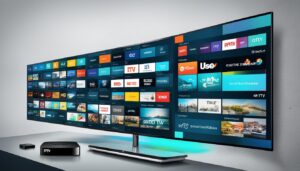Are you tired of being bound by cable TV packages and limited channel selections? Have you ever wondered how you can access a vast array of live TV channels and on-demand content from the comfort of your own home? Look no further than IPTV – the future of television streaming.
What is IPTV?
IPTV, or internet protocol television, is revolutionizing the way we consume television content. With IPTV, you can watch your favorite shows, movies, and sports events through an internet connection, eliminating the need for traditional satellite or cable TV services. But how does it actually work, and what sets it apart from other streaming platforms? Let’s dive into the world of IPTV and discover its inner workings.

Key Takeaways:
- IPTV delivers television content and other media over IP networks, such as the internet, instead of traditional broadcast or cable TV formats.
- Using IPTV, users can stream live TV, access on-demand content, and enjoy interactive features.
- IPTV offers a more flexible and personalized viewing experience compared to traditional TV services.
- Understanding the basics of IPTV, its technical mechanics, and the journey of an IPTV signal is crucial to fully grasp its capabilities.
- Quality of service plays a vital role in the seamless delivery of IPTV content.
The Evolution of Television: Introducing IPTV
In this section, we will explore the evolution of television and the introduction of Internet Protocol Television (IPTV). IPTV has disrupted traditional TV by offering a new delivery method and increased interactivity. We will discuss how the television industry has evolved over the years and how IPTV has revolutionized the way we consume media.
The Disruption of Traditional TV
Traditional TV, which relied on broadcast and cable formats, faced significant disruption with the emergence of IPTV. Unlike traditional TV, which had limited channel options and fixed schedules, IPTV expanded the range of available channels and offered viewers the flexibility to watch their favorite shows on-demand. This shift enabled viewers to have greater control over their TV viewing experience.
The Entry of Telecommunication Companies into IPTV
Telecommunication companies recognized the potential of IPTV and entered the market to provide television content through internet protocol networks. These companies leveraged their existing infrastructure and expertise in providing telecommunication services to offer IPTV services to their customers. This entry of telecommunication companies contributed to the growth and expansion of IPTV.
The Future Prospects of IPTV
The future prospects of IPTV are promising, as the technology continues to advance and consumer demands evolve. With the increasing availability of high-speed internet and the rise of smart devices, IPTV is expected to gain even more popularity. The ability to stream personalized content, interactive features, and the convenience of on-demand viewing are key factors driving the adoption of IPTV. As the technology evolves, IPTV is likely to become an integral part of the TV industry, offering innovative and immersive viewing experiences for users.
Understanding the Basics: What Is IPTV?
In this section, we will delve into the basics of IPTV and provide a solid foundation for understanding how it works and its key components. Let’s start by defining what IPTV is and how it differs from traditional TV.
IPTV, which stands for Internet Protocol Television, is a system that delivers television content and other media over IP networks, such as the internet, instead of traditional broadcast or cable TV formats. Unlike traditional TV, which relies on specific broadcast schedules, IPTV allows users to stream live TV, access on-demand content, and enjoy interactive features.
So, how does IPTV utilize internet protocol for content delivery? Well, instead of being transmitted through traditional broadcast methods, TV signals are converted into data packets and delivered through IP networks. This digital delivery allows for more flexible and efficient transmission, enabling users to access and consume TV content on various devices, such as smartphones, tablets, and smart TVs.
Understanding the basics of IPTV is crucial for grasping its technical mechanics and the unique features it offers. In the following sections, we will explore the transmission of IPTV over IP networks, the role of set-top boxes, the different types of IPTV services, and more. Stay tuned as we unravel the fascinating world of IPTV.
Unraveling IPTV: How It Transmits Over IP Networks
In this section, we will delve into the transmission of IPTV over IP networks and how it utilizes internet protocol for content delivery. IPTV, or Internet Protocol Television, is a system that delivers television content through IP networks, such as the internet, instead of traditional broadcast or cable TV formats. By leveraging IP networks, IPTV provides several advantages, including improved flexibility, scalability, and interactivity.

IPTV relies on internet protocol, or IP, to transmit video and audio data over networks. IP networks are the backbone of the internet, and they enable the seamless transmission of data packets from the source to the destination. With IPTV, television content is encoded into IP packets and then transmitted over IP networks to the end-user’s device.
One of the key differences between IPTV and standard downloadable media is the way content is delivered. In standard downloadable media, such as video or audio files, the entire file needs to be downloaded before it can be played. However, with IPTV, content is streamed in real-time, allowing users to watch TV shows or movies without having to download the entire file.
Unlike downloadable media, IPTV offers a more dynamic and interactive viewing experience. Users can pause, rewind, or fast-forward live TV streams, access on-demand content, and even interact with the content through features like video on demand or interactive TV. These unique features make IPTV a preferred choice for streaming content in today’s digital age.
| Advantages of IPTV | Differences from Downloadable Media |
|---|---|
| Flexibility Scalability Interactivity | Real-time streaming No need to download entire files Dynamic and interactive viewing experience |
Deep Dive: The Technical Mechanics Behind IPTV
When it comes to understanding IPTV, it’s crucial to have a grasp of the technical mechanics that make it all possible. In this section, we will explore the technology and infrastructure that drives IPTV, including streaming protocols and compression techniques.
To begin, let’s talk about streaming protocols. These protocols are responsible for governing the transmission of media content over IP networks. Some commonly used streaming protocols in IPTV include:
- Real-Time Streaming Protocol (RTSP): This protocol allows for the controlled delivery of live or on-demand media streams, ensuring a seamless viewing experience.
- Real-Time Messaging Protocol (RTMP): Used for high-performance transmission of audio, video, and data between a media server and a Flash player.
- HTTP Live Streaming (HLS): This protocol chunks media files into smaller segments and dynamically adjusts the quality based on the viewer’s internet connection, ensuring smooth playback.
These protocols play a vital role in delivering IPTV content to end-users, ensuring reliable and efficient transmission.
In addition to streaming protocols, compression techniques are essential in optimizing the delivery of IPTV content. Compression aims to reduce the size of media files without significantly impacting their quality. Two widely used compression techniques in IPTV are:
- H.264: Also known as Advanced Video Coding (AVC), H.264 is an industry-standard compression format that provides excellent video quality while minimizing bandwidth requirements.
- High Efficiency Video Coding (HEVC): HEVC, also known as H.265, is a newer compression standard that offers further improvements in video quality and bandwidth savings compared to H.264.
By utilizing streaming protocols and compression techniques, IPTV providers can deliver high-quality video content to viewers while optimizing network bandwidth and resources.
Furthermore, behind the scenes of IPTV, servers, encoders, and decoders play essential roles in the delivery process. Servers are responsible for storing and transmitting media content to viewers over the internet. Encoders are used to convert video and audio signals into a digital format suitable for transmission, while decoders decode these digital signals back into audio and video for playback on end-user devices.
Overall, understanding the technical mechanics behind IPTV gives us insight into the infrastructure and technology that enable the seamless delivery of TV content over IP networks. Streaming protocols, compression techniques, servers, encoders, and decoders all work together to provide viewers with an immersive and enjoyable IPTV experience.
Comparing IPTV with Traditional Cable and Satellite TV
In the world of television content delivery, there are various options available to consumers. Two longstanding methods have been traditional cable TV and satellite TV. However, with the advent of IPTV (Internet Protocol Television), a new player has emerged in the field. In this section, we will compare IPTV with traditional cable and satellite TV, exploring how IPTV streamlines content delivery and the benefits it offers over traditional methods.
How IPTV Streamlines Content Delivery
One of the key advantages of IPTV is its streamlined content delivery process. Unlike traditional cable TV, which requires the installation of physical cables and satellite TV, which relies on receiving signals from orbiting satellites, IPTV leverages IP networks, such as the internet, to deliver television content. This means that users can access their favorite shows and movies from anywhere with an internet connection, without the need for complicated installations or additional equipment.
IPTV also offers the convenience of on-demand streaming, allowing users to select and watch content whenever they want. With traditional cable and satellite TV, viewers are often limited by scheduled programming and have to wait for their favorite shows to air. With IPTV, users have the freedom to choose what they want to watch and when, giving them ultimate control over their viewing experience.
Benefits of IP Networks Over Traditional Delivery Methods
IP networks provide several benefits over traditional delivery methods like cable and satellite TV. Firstly, IP networks offer a higher level of scalability, allowing for the transmission of a wide range of content, including high-definition (HD) and even ultra-high-definition (UHD) content. This ensures that viewers can enjoy a superior visual experience compared to older delivery methods.
Secondly, IP networks allow for a more personalized viewing experience. With IPTV, users can customize their channel lists, create playlists, and even receive recommendations based on their preferences. This level of personalization enhances the overall viewing experience and ensures that users can easily discover new content that aligns with their interests.
Lastly, IP networks provide a more cost-effective solution compared to traditional delivery methods. With the rise of high-speed internet access, users can leverage their existing internet connection to access IPTV services. This eliminates the need for additional costly equipment or subscriptions, resulting in potential savings for consumers.
In conclusion, IPTV offers numerous advantages over traditional cable and satellite TV. Its streamlined content delivery, on-demand streaming, and the benefits of IP networks make it a preferred choice for many viewers. As the TV industry continues to evolve, it is evident that IPTV has revolutionized the way we consume television content, providing a more flexible and personalized viewing experience.
IPTV’s Unique Features and Interactivity
In this section, we will explore the unique features and interactivity of IPTV. IPTV offers a range of features that enhance the viewing experience and provide users with personalized content.
One of the key features of IPTV is personalized viewing. With IPTV, users have the ability to customize their viewing preferences. They can create personalized playlists, save favorite channels, and even receive recommendations based on their viewing history. This level of personalization ensures that users have easy access to the content they enjoy the most.
Another important feature of IPTV is interactivity. Unlike traditional TV, IPTV allows users to interact with content in real-time. Users can pause, rewind, and fast-forward live TV programs, giving them control over their viewing experience. Additionally, IPTV platforms often offer interactive features such as video on demand, where users can choose from a vast library of movies and shows to watch at their convenience.
IPTV also integrates additional services like VoIP and internet browsing. This means that users can make phone calls using their IPTV connection and even surf the internet on their TV screens. These added functionalities enhance the overall entertainment experience and provide users with more convenience and flexibility.
The unique features and interactivity of IPTV make it a preferred choice for those seeking a personalized and interactive viewing experience. Whether it’s customizing preferences, accessing on-demand content, or enjoying additional services, IPTV offers a new way to enjoy television.
Decoding IPTV Service Types: Live TV and Video on Demand
In this section, we will decode different types of IPTV services, with a specific focus on live TV and video on demand. IPTV offers a versatile range of content options, allowing users to access their favorite TV channels and explore a vast library of on-demand movies, series, and other media.
Live TV:
One of the key features of IPTV is the ability to stream live TV channels. IPTV providers offer various options for accessing live TV content, including:
- IPTV Service Packages: Users can choose from different IPTV service packages that include a specific set of live TV channels. These packages are often categorized by genre or language, providing users with a personalized selection of channels based on their preferences.
- IPTV Channel Guides: IPTV platforms typically provide channel guides that display the available live TV channels. Users can browse through the channel guide to find and select their desired channels, similar to traditional cable or satellite TV guides.
- Electronic Program Guide (EPG): EPGs are commonly included in IPTV services, allowing users to view program schedules and information for each channel. This feature enhances the user experience by providing a comprehensive overview of the available live TV content.
Video on Demand:
In addition to live TV, IPTV services also offer a wide range of video on demand content. Video on demand (VOD) allows users to access movies, TV shows, documentaries, and other media at their convenience, providing a more flexible viewing experience. IPTV platforms often feature a vast library of on-demand content, including recent releases, classic movies, and popular TV series.
With video on demand, users have the freedom to choose what they want to watch and when they want to watch it. They can browse through the available content, search for specific titles, and even pause, rewind, or fast-forward through the media as desired. IPTV platforms often offer personalized recommendations based on users’ viewing history and preferences, further enhancing the video on demand experience.
From Headend to Home: The Journey of an IPTV Signal
In order to understand how an IPTV signal reaches your home, it’s important to trace its journey from the content source to the end user. This section will explore the key components and infrastructure involved in delivering an IPTV signal.
National Headend: The Content Source
The journey of an IPTV signal begins at the national headend, which serves as the central hub for the distribution of content. The national headend collects and receives content from various sources, such as television networks, studios, and internet-based platforms. It acts as a content aggregator, ensuring a wide range of channels and programs are available for IPTV subscribers.
The content at the national headend is then processed, encoded, and prepared for distribution over IP networks. This involves compressing the content to optimize bandwidth and ensure efficient transmission. Once the content is ready, it is sent to local offices for further distribution.
The Last Mile: Local Offices and Set-top Boxes
From the national headend, the content is delivered to local offices, also known as regional headends or points of presence (POPs). These local offices serve as the intermediaries between the content source and the end user’s set-top box.
At the local offices, the IPTV signal is received and further processed for distribution to individual households. This involves routing the content to the appropriate set-top boxes based on user preferences and subscriptions.
The primary device used for receiving and decoding the IPTV signal is the set-top box. Set-top boxes are connected to the user’s television and serve as the interface between the IPTV service and the TV. They receive the encoded signal from the local office and decode it into the desired channel or program for display on the user’s TV screen.
Set-top boxes play a crucial role in the IPTV ecosystem, providing users with access to a wide range of channels, on-demand content, and interactive features. They allow users to navigate through the IPTV interface, select channels, browse program guides, and access additional services such as video on demand and interactive applications.
By ensuring the seamless delivery of the IPTV signal from the content source to the user’s home, the local offices and set-top boxes form the crucial last mile of the IPTV journey.
Accessing IPTV: Understanding Set-Top Boxes and Their Role
As IPTV continues to gain popularity, set-top boxes are making a comeback as a crucial component in accessing IPTV services. These devices play a vital role in facilitating the seamless delivery of IPTV content to your television.
Why Set-Top Boxes Are Making a Comeback
Set-top boxes have re-emerged as an essential tool in accessing IPTV due to their ability to bridge the gap between traditional television sets and internet-based streaming services. With a set-top box, you can enjoy the benefits of IPTV on your existing television, without the need for a smart TV or other sophisticated devices.
Set-top boxes bring IPTV channels and content right into your living room, enabling you to browse, select, and stream your favorite shows, movies, and other media offerings with ease. These devices offer a user-friendly interface and remote control, making the IPTV experience accessible to a wide range of users, regardless of their technical expertise.
Furthermore, set-top boxes often come equipped with additional features, such as the ability to record live TV, pause and rewind shows, and access on-demand content. These enhanced functionalities provide users with greater control and flexibility over their viewing experience, further fueling the resurgence of set-top boxes in the age of streaming.
The Integration of Set-Top Boxes in Home Networks
Integrating set-top boxes into home networks is a straightforward process that allows users to seamlessly incorporate IPTV into their existing setup.
Firstly, users connect their set-top boxes to their television sets using HDMI or other compatible connections. This establishes a direct connection between the set-top box and the TV, ensuring optimal picture and sound quality.
Secondly, the set-top box needs to be connected to the home network, typically through an Ethernet cable or Wi-Fi. This connection enables the retrieval of IPTV content from the internet and delivers it to your television, providing access to a wide range of channels and on-demand content.
By integrating set-top boxes into their home networks, users can enjoy the benefits of IPTV on their existing televisions while maintaining a familiar and comfortable viewing experience. This seamless integration allows for a smooth transition from traditional cable or satellite TV to IPTV streaming.

Set-top boxes play a crucial role in accessing IPTV services, bridging the gap between traditional television sets and internet-based streaming platforms. With their user-friendly interfaces and enhanced features, set-top boxes offer a convenient and accessible way to enjoy the wide range of content available through IPTV. By integrating set-top boxes into home networks, users can easily reap the benefits of IPTV while maintaining a familiar television viewing experience.
The Role of Quality of Service in IPTV Delivery
In order to ensure a seamless and enjoyable IPTV streaming experience, the role of quality of service (QoS) cannot be overstated. QoS refers to the ability of an IPTV service to deliver reliable streams with minimal interruptions, buffering, and lagging issues.
Ensuring Reliable IPTV Streams Through QoS
Quality of service plays a crucial role in delivering reliable IPTV streams to users. With the increasing demand for high-quality content and the use of bandwidth-intensive applications, QoS mechanisms are implemented to prioritize and allocate network resources efficiently.
By maintaining consistent network performance, QoS helps to prevent interruptions and buffering during IPTV streaming. It ensures that the necessary bandwidth is allocated to IPTV traffic, providing users with a smooth and uninterrupted viewing experience.
Addressing Multicast and Unicast Streaming Challenges
IPTV streaming can be divided into two main delivery methods: multicast and unicast streaming. Multicast streaming allows the simultaneous distribution of content to multiple users, conserving network resources. On the other hand, unicast streaming is a one-to-one delivery method, where each user receives a separate stream.
Implementing QoS measures is particularly important in multicast streaming, as it requires efficient bandwidth allocation to prevent congestion and ensure consistent stream delivery to all users. QoS mechanisms such as traffic prioritization and resource reservation help optimize multicast streaming, leading to improved reliability and quality.
With unicast streaming, QoS mechanisms play a vital role in ensuring the reliable delivery of individual streams. By efficiently managing network resources and prioritizing IPTV traffic, QoS helps minimize buffering and lagging issues that can occur in unicast streaming.
Conclusion
In conclusion, IPTV has revolutionized the television industry by offering a new way of delivering and accessing content. With its ability to stream live TV, provide on-demand content, and offer interactive features, IPTV has become a popular choice for consumers seeking a personalized viewing experience.
Throughout this article, we explored the basics of IPTV and how it differs from traditional TV. We discussed the technical mechanics behind IPTV transmission and the advantages it provides over standard downloadable media. We also compared IPTV with traditional cable and satellite TV, highlighting the benefits of IP networks and the streamlined content delivery provided by IPTV.
Furthermore, we delved into the unique features and interactivity of IPTV, such as personalized viewing experiences and video on demand. We discussed the journey of an IPTV signal from the content source to the user’s home, including the role of set-top boxes in accessing and integrating IPTV into home networks. Lastly, we addressed the importance of quality of service in providing reliable IPTV streams and overcoming challenges associated with multicast and unicast streaming.
In summary, IPTV is a game-changer in the television industry, offering users a wide range of content options, increased interactivity, and a more convenient and personalized viewing experience. With its continuous innovation and potential for future growth, IPTV is set to reshape the way we consume and enjoy television.
Check out other helpful resources:
10 Best IPTV APK Apps For Free – Digitalizard
How to install iptv smarters pro on firestick
FAQ
What is IPTV?
IPTV, or Internet Protocol Television, is a system that delivers television content and other media over IP networks, such as the internet, instead of traditional broadcast or cable TV formats.
How does IPTV work?
IPTV utilizes internet protocol for content delivery, allowing users to stream live TV, access on-demand content, and enjoy interactive features.
How is IPTV different from traditional TV?
Unlike traditional TV, IPTV uses IP networks for content delivery, providing a more flexible and personalized viewing experience for users.
What are the technical mechanics behind IPTV?
IPTV relies on streaming protocols, compression techniques, servers, encoders, and decoders to deliver content to end-users.
What are the advantages of IPTV over traditional cable and satellite TV?
IPTV streamlines content delivery and offers benefits such as a more flexible viewing experience and personalized content options.
What are the unique features and interactivity of IPTV?
IPTV allows for personalized viewing experiences, interactive features like video on demand, and integration with additional services like VoIP and internet browsing.
What are the different types of IPTV services?
IPTV services include live TV streaming and video on demand, offering users a variety of content options.
How does an IPTV signal reach the user’s home?
The journey of an IPTV signal involves content distribution from the national headend to local offices and ultimately to the user’s home through set-top boxes.
What is the role of set-top boxes in accessing IPTV?
Set-top boxes facilitate the seamless delivery of IPTV content and can be easily integrated into home networks.
How does quality of service (QoS) impact IPTV delivery?
QoS ensures reliable IPTV streams by minimizing buffering and lagging issues. Solutions are implemented to address multicast and unicast streaming challenges.





